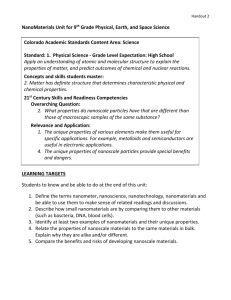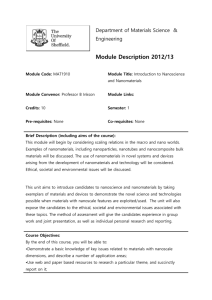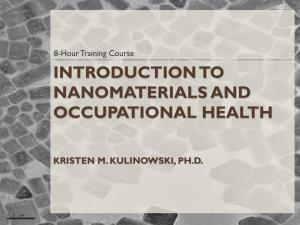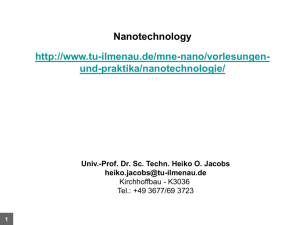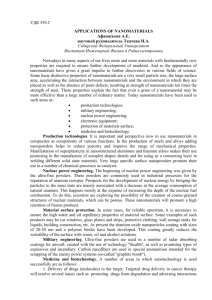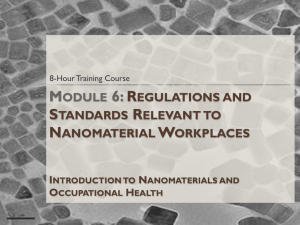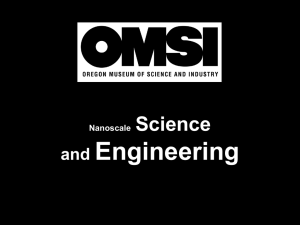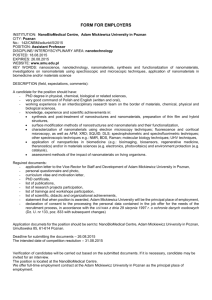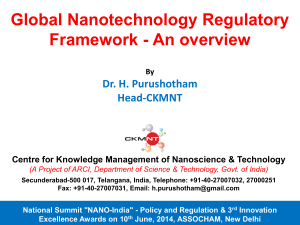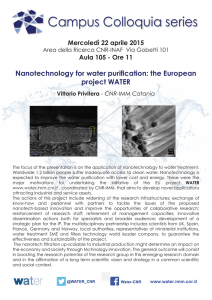Future-University
advertisement
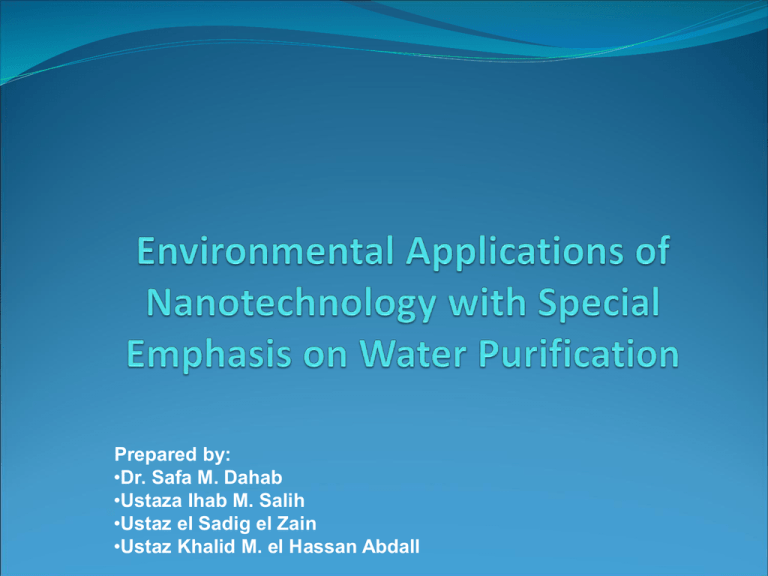
Prepared by: •Dr. Safa M. Dahab •Ustaza Ihab M. Salih •Ustaz el Sadig el Zain •Ustaz Khalid M. el Hassan Abdall Presentation Layout 1-Introduction 1.1- What is Nanotechnology? 1.1.1- Why nanoscale? 1.1.2- What is nanomaterial? 1.1.3- Nanomaterials’ characteristics 1.2- When Nanotechnology started 1.3- Approaches of Nanotechnology 1.3.1- Bottom-up or top-down? 2- Applications of Nanotechnology 2.1 General Applications 2.2- Environmental Applications 2.2.1- Water Purification 2.2.2- Conclusion 3- Environmental Implications 1.1- What is Nanotechnology? The design, characterization, and application of structures, devices, and systems by controlled manipulation of size and shape of materials at the nanometer scale (atomic, molecular, and macromolecular scale) , To produce materials with at least one novel/superior characteristic or property. Why Nanoscale? A nanometer (nm) is one thousand millionth of a meter. People are interested in the nanoscale because at this scale physical and chemical properties of materials differ significantly from those at a larger scale. Why Nanoscale? 1.1.2- What is nanomaterial? Is defined as any material that has unique or novel properties, due to the nanoscale ( nano metrescale) structuring. These are formed by incorporation or structuring of nanoparticles. They are subdivided into nanocrystals, nanopowders, and nanotubes: A sequence of nanoscale of C60 atoms arranged in a long thin cylindrical structure. 1.1.2- What is nanomaterial? carbon nanotubes 1.1.2- What is nanomaterial? Noble metal nanocrystals with cyclic penta-twinned structures 1.1.2- What is nanomaterial? Naonpowder 1.1.2- What is nanomaterial? Nanotubes are extremely strong mechanically and very pure conductors of electric current. Applications of the nanotube include resistors, capacitors, inductors, diodes and transistors. ),. 1.1.2- What is nanomaterial? Nanomaterials are interesting because at the small scale, materials have fundamentally different properties than at the bulk due to increased surface area to volume ratios. 1.1.2- What is nanomaterial? Increased interaction and reactvity is one of the by products of materials that are nanoscale, which means potentially using less of the material or that even on the nanoscale the properties are so utterly different from that of the bulk scale. 1.1.2- Nanomaterials’ Characteristics Most of them are novel, why? One definition of novel materials is: (new forms of existing materials with characteristics that differ significantly from familiar or naturally-occurring forms.) Nanomaterials can have one, two or three dimensions in the nanoscale: 1.1.2- Nanomaterials’ Characteristics Category of nanomaterials example One-dimensional nanomaterials layers, multi-layers, thin films, platelets and surface coatings. They have been developed and used for decades, particularly in the electronics industry. Two-dimensional nanomaterials nanowires, nanofibres made from a variety of elements other than carbon, nanotubes and, a subset of this group, carbon nanotubes. Three-dimensional nanomaterials are known as nanoparticles and include precipitates, colloids and quantum dots (tiny particles of semiconductor materials), and Nanocrystalline materials 1.2- When Nanotechnology started In some senses, nanoscience and nanotechnologies are not new. Chemists have been making polymers, which are large molecules made up of nanoscale subunits, for many decades and nanotechnologies have been used to create the tiny features on computer chips for the past 20 years. 1.2- When Nanotechnology started However, advances in the tools that now allow atoms and molecules to be examined and probed with great precision have enabled the expansion and development of nanoscience and nanotechnologies. 1.3- Approaches of Nanotechnology (growth methods ): 1.3.1- Bottom-up or top-down? Bottom-up approaches seek to have smaller components built up into more complex assemblies, while top-down approaches seek to create nanoscale devices by using larger, externally controlled ones to direct their assembly. The top-down approach often uses the traditional workshop or microfabrication methods where externally controlled tools are used to cut, mill, and shape materials into the desired shape and order. 1.3.1- Bottom-up or top-down? Micropatterning techniques, such as photolithography and inkjet printing belong to this category. Bottom-up approaches, in contrast, use the chemical properties of single molecules to cause single-molecule components to (a) self-organize or self-assemble into some useful conformation, or (b) rely on positional assembly. 1.3.1- Bottom-up or top-down? 2- Applications of Nanotechnology: 2.1 General Applications Application Examples Medicine Diagnostics, Drug delivery, Tissue engineering, Cryonics Information and communication Memory storage, Novel semiconductor devices, Novel optoelectronic devices, Displays, Quantum computers Heavy Industry Aerospace, Catalysis, Catalysis, Construction Vehicle manufacturers Consumer goods Foods, Household, Optics, Textiles, Cosmetics, Sports Environment 2.2- Environmental Applications Check http://www.nanowerk.com/products/product.php?id=160 for more details Application Examples Carbon capture Photocatalyst consisting of silica Nanosprings coated with a combination of titanium dioxide Sensors Pollutants sensors that able to detect lower limits with low cost Remediation (decontamination, oil spill management) Heavy metal decontaminant removes heavy metals such as lead, cadmium, nickel, zinc, copper, manganese and cobalt in a neutral pH environment without using any form of sulphur . Wastewater treatment Veolia Water Solutions & Technologies' ceramic membrane modules, utilizing the CeraMem technology platform, can be supplied with a variety of inorganic microfiltration and ultrafiltration membranes. Energy Heat distribution e.g. ceramic-like materials that provide sufficient reliability and durability of the entire structure Drinking water purification 2.2.1- Water Purification Global water budget Over 75% of the Earth surface covered with water. 97.5% of this water is salt water, leaving only 2.5% as fresh water. Nearly 70% of that fresh water is frozen in the icecaps of Antarctica and Greenland; most of the remainder is present as soil moisture, or lies in deep underground aquifers as groundwater not accessible to human use. 2.2.1- Water Purification Global water budget Less than 1% of the world freshwater (0.007% of all water of Earth) is accessible for direct human uses. This is the water found in lakes, rivers reservoirs and those underground sources that are shallow enough to be tapped at an affordable cost. 2.2.1- Water Purification Nanotechnology is used for: Detection of target analytes (metals, nutrientss, algae, biological agents) innovations in nanotechnology and nanosciences are having a significant impact in biodiagnostics, where a number of nanoparticle-based assays and nanodevices have been introduced for biomolecular detection. 2.2.1- Water Purification Nanofibers and nanobiocides: Electrospun nanofibers and nanobiocides show potential in the improvement of water filtration membranes. Biofouling of membranes caused by the bacterial load in water reduces the quality of drinking water and has become a major problem. Several studies showed inhibition of these bacteria after exposure to nanofibers with functionalized surfaces. 2.2.1- Water Purification Nanobiocides such as metal nanoparticles and engineered nanomaterials are successfully incorporated into nanofibers showing high antimicrobial activity and stability in water. 2.2.1- Water Purification Biofilm Removal: Various studies have focused on the enzymatic degradation of polysaccharides and proteins for biofilm detachment since these are the two dominant components of the extracellural polymeric substances EPS. The activity, stability and efficiency of immobilized enzymes can be improved by reducing the size of the enzyme-carrier. 2.2.1- Water Purification Nano-scale carrier materials allow for high enzyme loading per unit mass, catalytic recycling and a reduced loss of enzyme activity. Furthermore, enzymes can be stabilized by producing single-enzyme nanoparticles consisting of singleenzyme molecules surrounded by a porous organic-inorganic network of less than a few nanometers thick. 2.2.1- Water Purification Nanofiltration: Is a new type of pressure driven membrane process and used between reverse osmosis and ultrafiltration membranes. The most different speciality of nanofiltration membranes is the higher rejection of multivalent ions than monovalent ions. 2.2.1- Water Purification Nanofiltration membranes are used in softening water, brackish water treatment, industrial wastewater treatment and reuse, product separation in the industry, salt recovery and recently desalination as two pass nanofiltration system. Reverse osmosis is based on the basic principle of osmotic pressure, while nanofiltration makes use of molecule size for separation. 2.2.2 Conclusion Nanotechnology could potentially lead to more effective means of filtration that not only remove more impurities than current methods but do so faster, more economically and more selectively. 3- Environmental Implications As previously noted, the potential widespread application of nanomaterials in environmental remediation is made possible by the miniaturization of materials down to the nano-scale. However, this same enabling characteristic also influences risk by changing the particles' potential for mobility, exposure, absorption, reactivity, and toxicity. 3- Environmental Implications When a nanomaterial is used for environmental remediation, it is intentionally introduced into the environment to exploit its unique properties. Nevertheless, nanomaterials can have side effects, and a risk assessment requires knowledge of their distribution in the environment and food chain. 3- Environmental Implications Risk assessment is required for understanding the nanoparticles’ behavior to evaluate potential risks associated with nanomaterial use for remediation. Side effects associated with the use of nanotechnology, especially environmental risks associated with residual nanomaterials’ fate and transport in the environment, are not yet fully explored and understood. 3- Environmental Implications Uncertainties of the nature and interaction of nanomaterials in the following areas add to the complexity of risk concerns. a- Uncertainty in relationship between size, surface area, and surface reactivity b- Uncertainty in relationship of radionuclide and nanomaterials. Thank You for Your Attention
